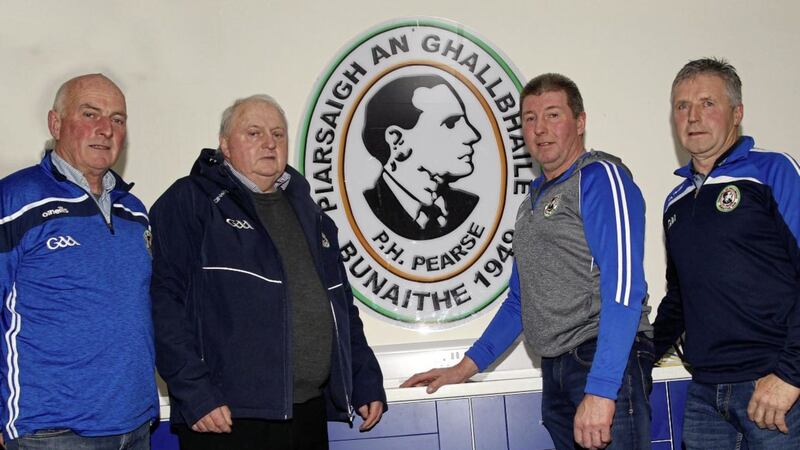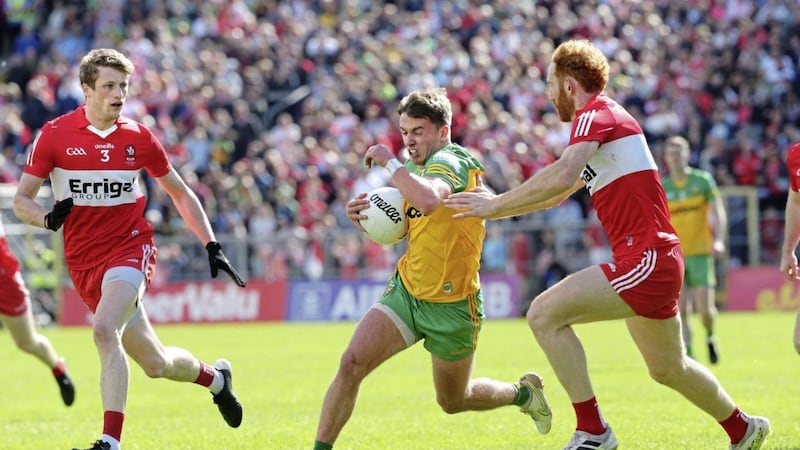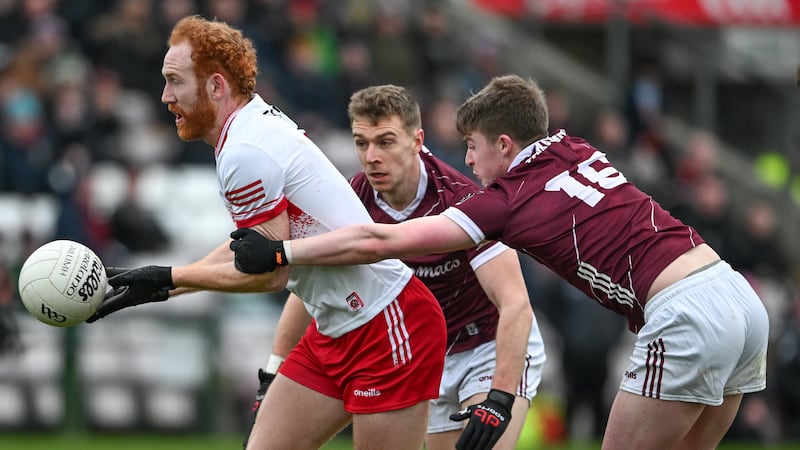THE drive into Galbally could be mistaken for the drive into any peacetime, Celtic Tiger village in Ireland.
It’s barely a mile-long stretch on the road between Carrickmore and Donaghmore, to which it’s tied as the smaller end of the parish.
There are a few big houses dotted across the place, but by far its most remarkable feature is the few acres of land that house the GAA club and community centre.
Eleven days out from the Ulster intermediate final, Galbally’s players are dribbling out of the changing room for training on one of their three full-size, floodlit pitches.
Since the erection of the new community centre in 1995, over £1.8m has been invested in the playing grounds. Their facilities would put most clubs to shame.
Football has illuminated the place in recent years. With a first adult championship since 1958 under them and a place in this Saturday night’s Ulster intermediate final secured, these are the boom times for Galbally Pearses.
It’s far removed from the dark times of the past, when the area’s deep-rooted republicanism made the area and its people a target during the Troubles.
Sat in the heat of the club’s committee room upstairs in the community centre, the background noise amounts to the odd roar off the training pitch below.
It’s a change from the 1980s and ‘90s, when army helicopters would circle both Galbally itself and Cappagh, a neighbouring hamlet from which Galbally club draws players.
At the height of things, the four veteran members sat around the table – Sean Carberry, Pat McKeown, Kieran Brannigan and Pauric Rafferty – can vividly recall drivers being stopped by the RUC or army or UDR every single day.
“Back that time, you’d have been stopped going to matches and searched. Your football stuff would have been pulled out of the car, thrown out of the bags and on to the road,” says Carberry.
“You couldn’t go from here to Tally’s [pub] without getting stopped by the police or the army,” added McKeown, who was part of the Tyrone panel that reached the 1986 final.
“If you went to go to Dungannon, you mightn’t get back for two hours. People got that well used to it that they nearly didn’t pass any remarks.”
Cappagh itself was almost completely blocked off.
“They used to have big bollards up in the middle of the street, they were feared of loyalists driving a car bomb up into the middle of Cappagh,” recalls Brannigan.
“They had bollards on either side, to stop anyone coming through. These were big lumps of concrete, with just enough room for someone that knew to get through, but they were set up that someone couldn’t come and just drive on through it.”
But in January 1972, loyalist gunmen timed it right. They squeezed through the bollards and went in to Ruby’s Bar, where they shot and killed local man Dinny Hughes.
Owner Francie ‘Ruby’ Boyle was wounded, as was Pat McCaul, who died a short while later after a fall while recuperating from his injuries.
That was the first loyalist attack on the area, and the last major one would be in Boyle’s Bar 29 years later, where Provisional IRA members John Quinn (22), Dwayne O’Donnell (17) and Malcolm Nugent (20) were ambushed in their car as they pulled up outside the bar in early March, 1991.
A fourth man, 52-year-old civilian Thomas Armstrong, was also killed when the gunmen fired through an open toilet window after those inside had barricaded the doors.
In the 30 years in between, young men were carried shoulder high to their rest far too often.
* * * * * * * * * * * * *
MARTIN Hurson and Seamus Donnelly were both reared down the one lane, directly behind the club’s ground.
Hurson was one of Johnny and Mary Ann’s nine children. He played underage football for Galbally but then went off to England for 18 months.
When he returned, he was one of seven men lifted in raids by the army and RUC across two midweek mornings in November 1976. Among them were Peter Nugent and Jimmy Rafferty, who were players for the club at senior level.
“Peter Nugent never played a game without coming off the field with the jersey tore off him,” laughs Brannigan.
“They had them lifted for seven days that time, they took them to Omagh. Martin Hurson got his arm or leg broke,” says McKeown.
“They beat the other fellas 'til they finished up signed statements and got done. Peter Nugent and Jimmy Rafferty were badly tortured too but they managed to hold it together.
“They got an awful tormenting after that, they couldn’t put their noses out to go anywhere but they were being stopped.”
Martin Hurson was convicted of involvement in three IRA landmines, two of which were in Cappagh and Galbally in late 1975, and was imprisoned for 20 years.
He joined the hunger strike in 1981, replacing Brendan McLaughlin who withdrew following a perforated stomach ulcer.
Hurson died after 46 days on the blanket.
“The Hurson family were big supporters of the club,” says Brannigan.
“There’s a tournament run here every year in honour of Martin Hurson. It’s going since ’84 and still running.”
Pat McKeown takes over: “Martin Hurson dying on hunger strike, and him a Galbally man… It was after the whole thing happened that people actually realised what he’d done, that 10 men had died and one of them was from our area.
“To do something like that, to go down as one of the greatest Irish men that ever was. Martin Hurson was one of them and he came from Galbally.
“It was disappointing and heartbreaking surely, but it gave everyone in the area a lift that there was a man like that who was willing to sacrifice himself for everybody else.
“That’s why this area became the stronghold down the years that it did, it was on the back of men like that and the like of Loughgall. It made everybody stronger, to say ‘f*** yous, you aren’t going to beat us’.”
Seamus Donnelly was 19 years of age when he was one of four men from the Galbally/Cappagh area killed when the SAS lay in wait for the East Tyrone IRA unit outside Loughgall police barracks in 1987.
Declan Arthurs (21), Tony Gormley and Eugene Kelly (both 25) were among the eight republicans shot dead in the attack. Kelly and Arthurs had both played underage football for Galbally, while Donnelly’s brother Michael was a key player for the seniors.
“Young Pick [Michael] would have been a very good footballer, very young at the time,” says current club chairman Sean Carberry, who was also playing then.
“I remember playing a championship game the Sunday before and Pick picked up an injury against Brackaville. He hurt his shoulder.
“The next time we saw him, he was carrying his brother’s coffin. That was tough.”
There were arrests and internments, and the losses hammered the community. It had a major impact on the club’s ability to function.
The biggest loss in terms of playing resources was Martin McCaughey, who also joined the armed struggle.
Galbally had never been overloaded with potential county players, but they were hitting a purple patch in the mid-80s.
Plunkett, Brian and Sean Quinn – none of them related – had been county minors the year before McCaughey made the cut for Tyrone.
Mostly he was a half-forward, but “you could have played him anywhere. He was a hardy boy,” recalled Kevin Brannigan.
He played off and on in his early senior days, coming on in the playoff against Drumquin that they won in 1986 that took them out of junior football.
“It was played on December 23 and it snowing on us,” says McKeown.
“Plunkett Quinn, his two lads play now, scored three goals that day.”
But having lost four of his closest childhood friends in the Loughgall massacre, McCaughey was killed three years later at the age of 23.
Fourteen SAS soldiers, operating on a shoot-to-kill policy, unleashed a hail of bullets and killed McCaughey and Dessie Grew, both of whom were unarmed.
There are links to the past woven through the current team.
Martin McCaughey’s two nephews, Peadar and Oisin, are both on the squad. Cormaic Donnelly is a nephew of Seamus.
Dwayne O’Donnell, who was just 17 when he was shot in Boyle’s Bar in 1991, has a nephew, Caoimhin Quinn, part of the team.
“The young boys would still all know about those men we’re talking about because there’s commemorations and those men are always kept in the minds of people around here through different things,” says Pat McKeown.
“Those young boys have grown up going to those things. They don’t be running about talking about it the way we did years ago, but they know what went on.
“That’s something about around here – those men will always be remembered, and kept in the minds of young people coming up. They’ll never be forgot about, regardless of the football. Those lads will always know them.”
* * * * * * * * * * * * *
THE Troubles weren’t unique to Galbally, and nor were the other struggles.
Keeping a GAA club going in rural Ulster wasn’t an easy task in any circumstances. Most weeks, they had 17 or 18 players.
Pauric Rafferty recalls going out after second mass on a Sunday, around the houses to sell £5 tickets for a non-stop draw just to pay their fees.
“The 70s and 80s were hard. There was no money. We had one team – now we have 21 between boys and girls. There’s more young families about now and things are a lot better, there’s more money about.”
His memory is bordering on photographic, right back to the senior final they reached in 1963. The likes of Terry Kelly, Patrick McGeary, Jim Beggs, Paddy Tally’s father Pat, were part of a strong troupe that beat rivals Donaghmore in the semi-final, but without a couple of those key players, they found a strong Omagh outfit too much in the decider.
They were only in senior football a couple of years and dropped to the bottom rung soon after. They won a junior league in ’77, losing a championship final to Brocagh in ’86 but winning promotion via the league playoffs that year.
Two things really turned the club around. Danny Kerr and Patrick McGeary took on to drive the club’s underage, focussing for the first time on coaching the youth.
And Benny Haughey, a three-in-a-row winner with Carrickmore in the late ‘70s, was brought in as senior manager in 1984.
“We had a committee meeting here and we needed a manager,” recalls Sean Carberry.
“Francie Martin of Carrickmore’s name was mentioned, so me and Ned Murphy headed off to see him. He said he couldn’t take it but that there was a man over the road would be interested – Benny Haughey.
“He came here in ’84, and I mind he started training before Christmas. He came down here one Sunday and there was about four inches of snow sitting on that field.
“We were sitting in the cars waiting on Haughey coming down to see, thinking he’d say ‘go home’. He came and says ‘what are yous all doing sitting there, tog out!’ I remember he togged out too and we went out on to that field,” he says, pointing out the window.
Haughey upped the training to three nights a week and with a good crop of players coming through, Galbally started to climb the hill.
They won promotion in 1991 and six years later, they reached a second senior championship final, where they would face Errigal Ciaran.
But the day before the game, teenagers Ciaran (19) and Michael McGeary (14), whose father Patrick had done so much to help build the club’s underage structures, were tragically killed in a car accident on the old Ballygawley line.
The game was put back a week, but the heartbroken people of Galbally had no heart in playing it.
Other years, they just couldn’t get past the might of Errigal Ciaran or Carrickmore.
The club stayed in senior football for 20 years until 2010, and during that time they’d delved deep into the community and started about laying the foundations for what’s there today.
Having bought the grounds in 1992 for £30,000, they spent six months on the road selling a £60 draw and paid for the land almost outright.
They haven’t stopped turning the wheels on it since, chipping away at a bit here and a bit there until they’ve finished up with a superb setup that has floodlighting on three of the four fields, a stand on the main field and a running track around all their pitches.
“It was down to the people to go out and push the thing, and that’s why that place out there is the way it is,” says McKeown.
“The people around here worked hard and pushed hard to get selling tickets.
“There were days there could have been 40 men out there on a Saturday, doing voluntary labour for nothing. That went on for months and months.
“People in Galbally always had great pride in their area and themselves, even when there was nothing here. You always took great pride.
“If someone asked you where you were from, it was Galbally, even if we were playing out on that field and the rushes were a foot high and turf banks beside us. You still thought: ‘We’re from Galbally, it doesn’t matter about anybody else’. That carried on through us.
“We pushed on, we got lads out playing football, we started to gather money.
“It was down to hard work and pride in the area we lived in. We’ve come through some very hard times here and I think it bonded everybody together that much more.”
And they lived it too, when they could. The club brought a bus out of England in the late ‘80s that was used for ferrying everyone from the U12s to those that went in to Edendork for the bingo. It had ‘Ortibel’ written across the front of it and that’s all they called it.
Once, they took it to Manchester and heading up the motorway, Brannigan pulled out and passed a lorry that was carrying a digger.
"Next thing I looked in the mirror and he’s coming up past me again, and there’s a pile of smoke coming out of us," he laughs.
"Everybody can talk about Ortibel yet.”
This year’s intermediate final win over Pomeroy brought them a first championship success since they won the junior title in 1958.
And now they stand 60 minutes from an Ulster title. It’s territory they couldn’t have dreamed of, even at the start of this year.
The four men rave about John Moylan and the local men at his side. And the players themselves.
And they're thankful for the area’s peace too.
“It would be a big help, wouldn’t it?” says Pauric Rafferty.
“There’s no other distraction other than going to college and football. You’re running around the roads and getting beat and stopped and pushed about, it’s not good.
“This is a special group of lads that are dedicated to the club and football.”
Galbally’s people have never, and will never, be anything but proud of all that they are.
They’ll play senior football again in 2020, and they could do so as Ulster intermediate champions.
It’s a different world now.








